It’s been a very long time coming, but it’s finally here, the first fully electric vehicle for Ford has arrived in Australia, the new Ford E-Transit. While it’s not a consumer vehicle, the Mustang Mach-E is on its way later this year.
Ford is pitching the new all-electric E-Transit as the same Ford Transit Australians know and trust to get the job done but with the added benefit of zero emissions, reduced noise and lower operating and maintenance costs for business operators.
The E-Transit is being offered in 2 variants, the long-wheelbase 420L BEV Mid Roof and 420L BEV High Roof, with deliveries expected to start in the coming weeks.
Both models of the E-Transits are powered by a 198 kW electric motor delivering 430 Nm of torque to the rear wheels, the highest power and torque outputs of the Transit range.
The electric motor is supplied by a 68-kWh lithium-ion battery pack and while the size of the van likely provides space for capacity, there’s always the commercial decision about range versus the cost you’re targeting. As with most modern EVs, the battery is located beneath the load floor in a sealed structure with side-impact protection as standard.
| E-Transit | 68 kWh Electric Motor |
| Max. Power | 198 kW |
| Max. Torque | 430 Nm |
| Transmission | 1-Speed Automatic |

Technology
Simply because this vehicle falls into the commercial space, doesn’t mean the expectations from drivers are any less when it comes to technology in 2023. The entire Transit range features Ford’s SYNC 4. With twice the computing speed of SYNC 3, it offers an intuitive 12″ glare-resistant touchscreen and a number of other features including:
- Wireless Smartphone Integration: connects to Apple CarPlay and Android Auto without a USB cable.
- Connected Built-In Satellite Navigation: provides the most efficient route, live updates on traffic and parking, available charging points (that can be filtered by charging efficiency), and even the latest weather updates.
- Scheduled Pre-Conditioning (heating and cooling): is designed to help maximise run time when vehicles are charging, allowing drivers to bring the vehicle cabin to a desired temperature while still plugged in, helping preserve battery charge for use on the road. This capability is available via the ‘Departure and Comfort’ selection accessed through the ‘Features’ menu in the SYNC 44 screen.
- Digital Owner’s Manual: allowing customers to search for vehicle information on demand using the touchscreen.
Connected Services
FordPass is the ultimate partner for E-Transit drivers, giving customers access to Remote Start and Remote Unlock from their mobile phone, as well as key Electric Vehicle (EV) connected services and charging information including:
- FordPass Power My Trip: which works with Connected Built-In Satellite Navigation to help customers plan trips that include convenient charging stations along their route:
- By entering their destination directly into SYNC 4 or via the FordPass App, ‘Power My Trip can consider E-Transit’s current state of charge in addition to real-time traffic conditions to help identify charging stops when a customer will need them.
- The feature includes estimates of the amount of time spent at each charging station and can also suggest different routes based on driver preferences such as: time taken, distance travelled, or optimal economy.
- Battery Charge Level
- Distance to Empty (km)
- Nearby Chargers
- Charge Settings: allowing customers to set up preferred Charge Times and add Departure Times.
- Charge Logs
Active Safety and Driver Assistance
Ford also has a strong safety story as well with the E-Transit featuring the same high level of active safety and driver assistance available including:
- Autonomous Emergency Braking (AEB) with Pedestrian Detection
- Adaptive Cruise Control
- Blind Spot Monitoring System
- Blind Spot Assist
- Hill Launch Assist
- Intersection Assist
- Lane Keeping Aid with Lane Departure Warning
- Traffic Sign Recognition
- Rear Camera
- Rear Parking Sensors
- Auto Hold (E-Transit only)
Ford continues their hands-on the wheel, eyes-on the road mantra, allowing users to control many of the vehicle functions using voice commands.
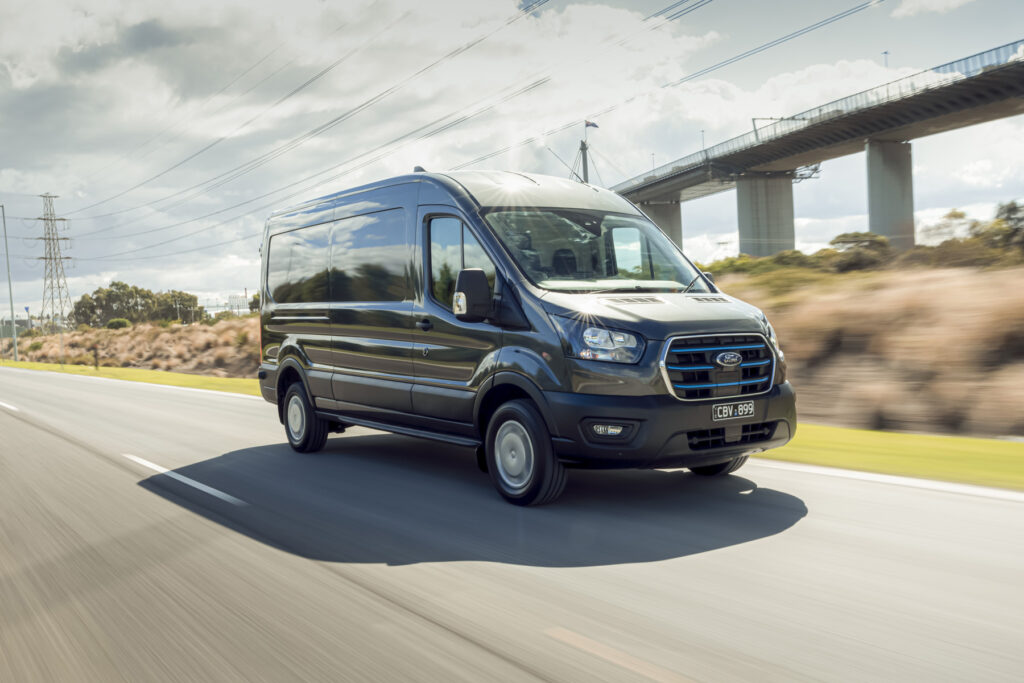

Driving Range
The range will be a really critical factor for those commercial operators considering an Electric van. Ford says the E-Transit has a maximum driving range of more than 2.5 times the average distance a commercial van travels each day.
| Driving Range | 420L BEV LWB RWD – Mid Roof | 420L BEV LWB RWD – High Roof |
| Worldwide Harmonised Light Vehicle Test Procedure (WLTP) Overall Range (Kilometres) | 230-307 | 222-295 |
When we look at these range figures, it’s important to realise, these are best-case scenarios, which means there’s no payload in the back, which is an important number, as trips back from deliveries will meet this profile.
The Australian Bureau of Statistics lists the average distance a commercial van travels each day in Australia as 44.8 kilometres, while the average rigid truck travelled 56.8 kilometres a day and the average articulated truck travelled 217.5 kilometres in a day.
If those figures are true, Ford is actually underselling the range multiple.
I could see the van being used for many tasks in urban environments like flower or parcel delivery, and transporting goods from Ikea and of course, there are opportunities like converting it into a powered coffee van for a business on the go.
Ford is unlikely to provide the worst-case scenario, which is really when the vehicle is at its heaviest, fully loaded with up to 1,600kg payload plus the driver, in cold weather (with the heater on) and windy. Under these conditions, you’d get much less but is likely to be viable for many businesses.
As with all-electric vehicles, the actual driving range varies with conditions such as external elements – including temperature, driving behaviours, route profile, vehicle maintenance, and lithium-ion battery age and condition.
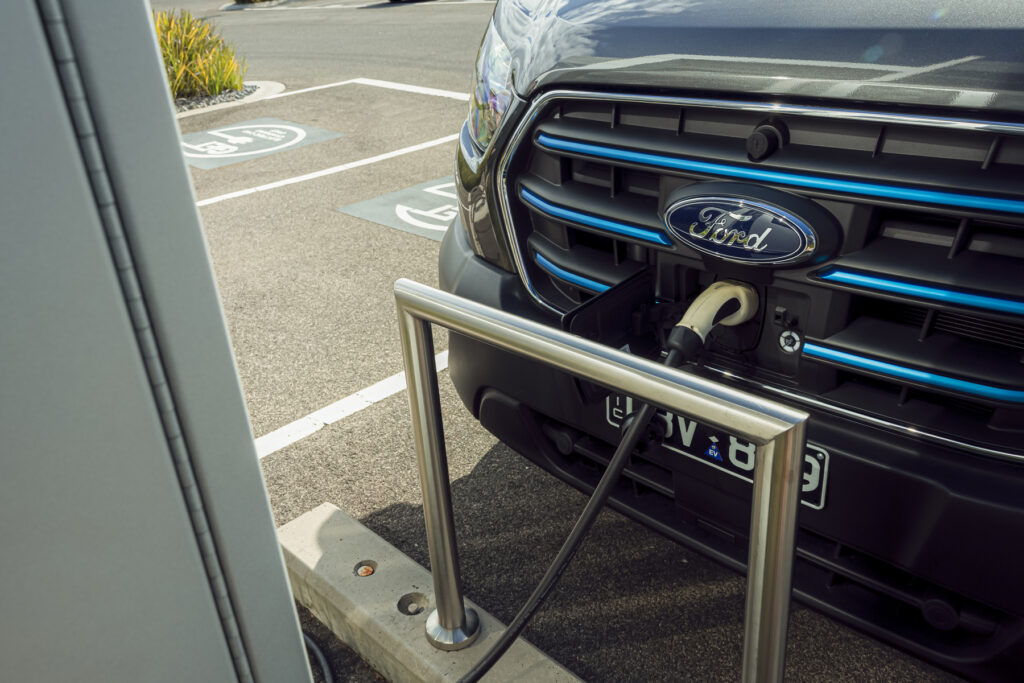

Charging
Electric vehicles have a wide variety of charger locations and Ford has mounted the charging port in the front grille. They say this is designed to make charging easy and E-Transit comes equipped with a Mode 3, 32-amp Charge Cable as standard.
Flexible charging options allow customers to either AC charge overnight in approximately 8 hours or quick DC Charge Top Up (15 per cent to 80 per cent at 115 kW) in approximately 34 minutes, giving commercial customers the confidence to complete day-to-day operations.
While 115kW DC fast charging isn’t fast compared with the best 350kW rate, given the size of the battery, it can still achieve a very acceptable 34-minute charge time to go from 15-80% state of charge, which I think is representative of many daily use cases.
Businesses need to consider their charging infrastructure at work, as this will be part of the cost considerations for the overall return on investment.
If there’s 3rd party DC fast charging available, that will also be an option, with the E-Transit leveraging the common CC2 connector. This means networks like Chargefox, Evie, Ampol and others are compatible with this vehicle, although you may get some strange looks from the passenger vehicles.
| Charging Summary | 68 kWh Electric Motor |
| On-Board Charger (AC) | 11.3 kW |
| Fast Charging Capacity (DC) | 115 kW |
| Charging Cable | Mode 3 (Type 2, 32A) |
| AC Charging Time(3 Phase At 11 kW)0-100% | 8.2 hours |
| DC Fast Charging Time (At 115 kW) 15-80% | 34 minutes |
The Ford E-Transit also features regenerative braking, generating energy from electricity ordinarily lost with coasting or light braking. The recovered energy is then stored in the traction battery to maximise range.
This lift-off regeneration is always active but optimised in ‘Low’ mode accessed via the rotary e-shifter.


Drive Modes
E-Transit’s three drive modes are tailored to its electric powertrain, and are available via the 12’’ SYNC 4 Touchscreen or via a dedicated button on the centre console:
- Normal Mode: is the default drive mode for the vehicle and is tuned for everyday driving, balance, and comfort.
- Eco Mode: is tuned to maximise driving range and aims to improve energy use by between 8 and 10 per cent if E-Transit is driven unladen, or at highway speeds, by limiting the maximum speed, regulating acceleration, and optimising climate control.
- Slippery Mode: improves vehicle traction in low-grip road conditions.
Independent rear suspension
The rear suspension of the E-Transit has been re-designed to maximise carrying capacity and improve performance.
Specifically, E-Transit features an extremely compact heavy-duty semi-trailing arm suspension system that enables better steering precision and more confident handling, plus better traction in both laden and unladen conditions.
The compact nature of the suspension also allows for an uncompromised cargo capacity of up to a maximum load space of 11 cubic metres in mid-roof specification and 12.4 cubic metres for the high-roof version, both of which are identical to the Transit 350L RWD diesel equivalents.
Gross vehicle mass of up to 4.25 tonnes is offered, with a payload of up to 1,611kg on the mid-roof van and 1,566 kg for the high-roof van.
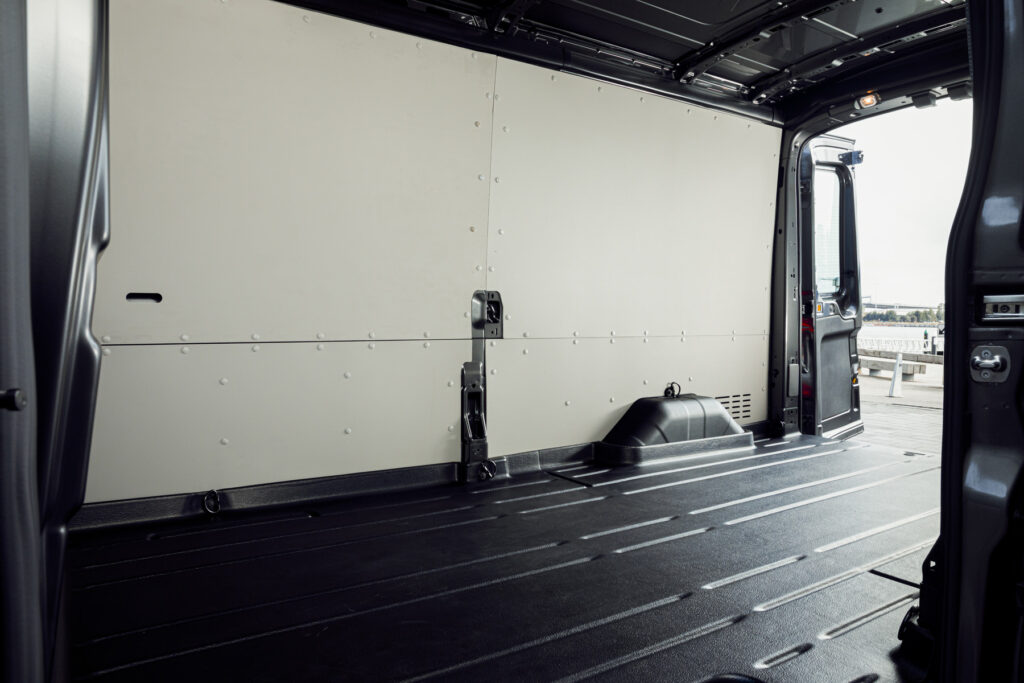

Tested To Extremes
To ensure the vehicle was fit for Australian conditions, Ford engineers put the E-Transit through a ‘boot camp’ for vehicles during an exhaustive test regime for customers operating in the most arduous situations.
During the tests, the all-electric E-Transit took on challenging winter driving conditions in Michigan, US; simulated extreme heat, cold and altitude in Ford’s Environmental Test Chamber in Cologne, Germany; and the giant potholes and rough road surfaces at the company’s Lommel Proving Ground in Belgium.
Ford punished the E-Transit through a rigorous series of tests to ensure durability. The no-compromises approach recreates the effects of more than 240,000 kilometres of driving – or a decade of hard work – for the average customer.
Ford’s Environmental Test Chamber created conditions from the Sahara to Siberia. Engineers refined the all-electric powertrain and cabin environment for performance and efficiency by subjecting E-Transit to more than 40 degrees Celsius for two weeks using 28 spotlights with 4,000-watt bulbs. E-Transit’s battery pack features liquid-cooling technology for optimum performance in extreme weather.
The van also had to prove it could function at -35 degrees Celsius and with a full load making the punishing climb to 2,500 metres, as high as Austria’s Grossglockner High Alpine Road, one of the highest paved roads in Europe.
Thousands of passes over dedicated tracks of bumps, potholes and cobbles were performed at Ford’s Lommel facility, simulating cobbled streets, rough back roads and challenging un-made tracks from around the world.
The durability of the E-Transit’s battery pack, electric motor and unique rear suspension were tested by repeatedly driving the new model through mud and salt baths and through saltwater sprays, simulating winter roads and fords as well as testing the components’ corrosion resistance.
The electric motor’s reliability was proven by running it continuously for 125 consecutive days.
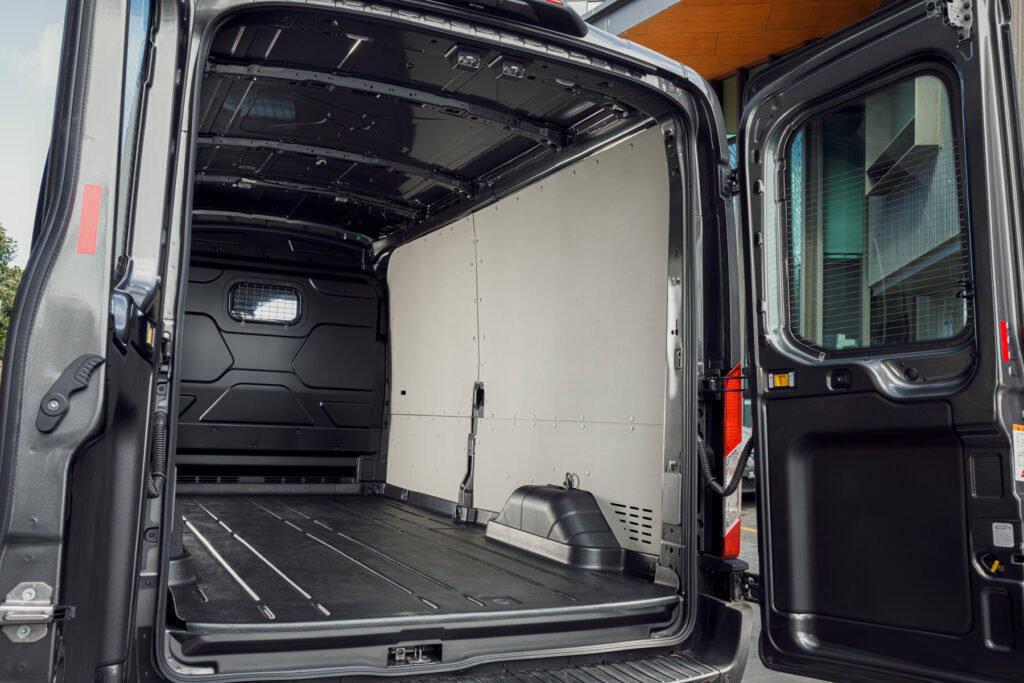

Cargo Capacity and Weights
Cargo capacity is essential for all Transit customers and E-Transit’s vehicle architecture has been designed with that in mind.
By locating the vehicle battery under the load floor, the E-Transit engineering team ensured the cargo volume was uncompromised, matching the load space of the diesel equivalent, the Transit 350L.
Capacity offered is a maximum load space of 11 cubic metres on the mid-roof and 12.4 cubic metres on the high roof with a payload of 1,611 kg for the 420L BEV mid-roof and 1,566 kg for the 420L BEV high roof model.
Because the load area on the EV-Transit is largely the same as conventionally powered Transits, many load area conversions will carry over to E-Transit with minimal modifications, making it easy to adopt an E-Transit into a business fleet.
Also, with the battery pack located where it is, this gives E-Transit a low centre of gravity. Combined with its rear-wheel drive and compact coil-sprung rear suspension, E-Transit has excellent traction and stability in both laden and unladen conditions. This is consistent with the passenger car-like driveability that Transit is known for.
| 420L BEV LWB RWD | 420L BEV LWB RWD – High Roof | |
| Load Space Maximum (cubic metres) Single Side Load Door (with Bulkhead) | 11m3 | 12.4m3 |
| Gross Vehicle Mass (GVM) – kg | 4250 | 4250 |
| Maximum Payload – kg | 1611 | 1566 |
| Kerb Weight – kg | 2639 | 2684 |
Warranty
As a base vehicle, E-Transit will be covered by Ford’s five-year, unlimited-kilometre Express New Vehicle Warranty which sits alongside the eight-year or 160,000 km (whichever occurs first) warranty package for the battery and high-voltage electric components.
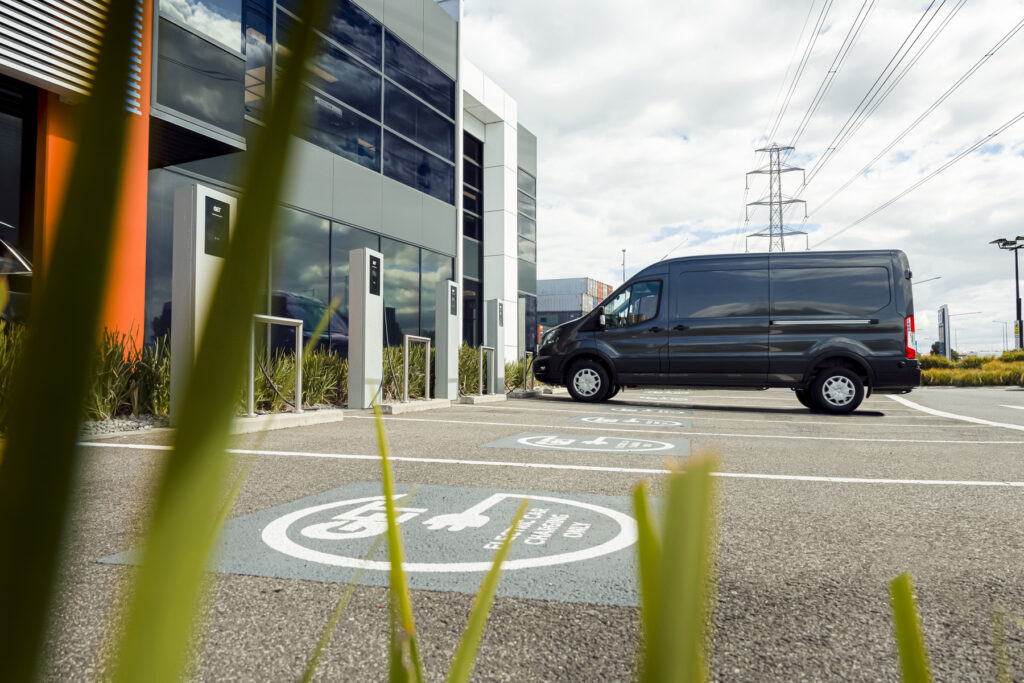

Price and Servicing
The Ford E-Transit is available now, priced from $104,990* (MLP), and can be purchased exclusively through an Authorised Ford EV Dealer.
A more spacious ‘high-roof’ body can be optioned for $1500*. The E-Transit has 12-month / 30,000 km service intervals (whichever comes first).
There are a number of options available, but I think the commercial reality is, we’re likely to see many of these arriving in the base paint colour.
Options (MLP)
| E-Transit 420L LWB RWD Van AT | |
| Prestige Paint | $700 |
| Special Vehicle Options (SVO) Paint | $1,400 |
| Single Front Passenger Seat (in lieu of Dual Front) | $150 |
| Doors – Dual Side Load Doors (Left and Right Side) | $1,000 |
| High Roof | $1,500 |
More information about E-Transit is available at https://www.ford.com.au/future-vehicle/e-transit/
Overall, I’m glad Ford finally has their first EV in the Australian market and this appears to be just the start, with Ford planning to bring at least 5 electrified vehicles down under by the end of 2024 (let’s hope most of them are fully EV).
